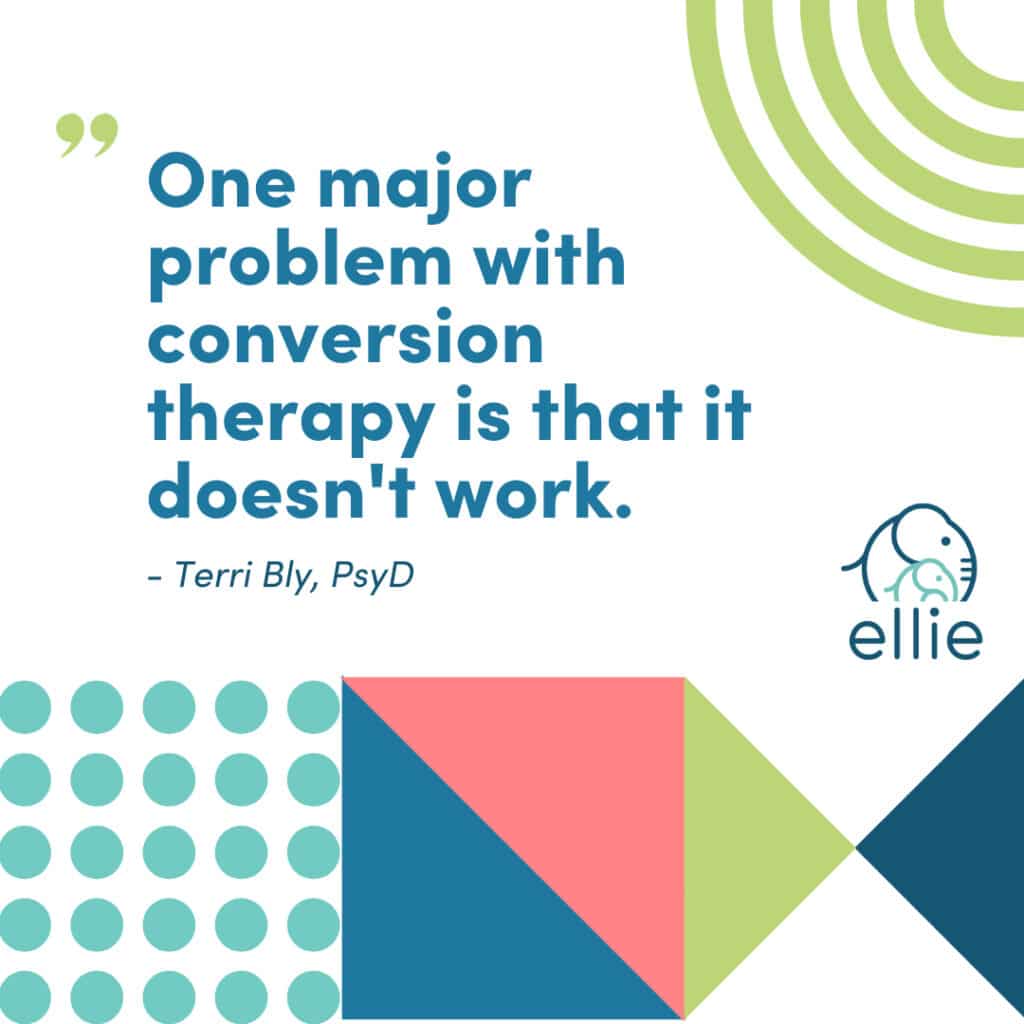According to a recent study by the Williams Institute at UCLA, approximately 698,000 adults in the US have received conversion therapy, and about 350,000 of them were adolescents at the time of the treatment. It is also estimated that another 16,000 of American teens will participate in conversion therapy with a licensed mental health provider before they reach adulthood, and around 57,000 American teens will undergo conversion therapy efforts with a religious or spiritual advisor.
As of April 2023, 21 states and the District of Columbia have passed laws prohibiting licensed mental health professionals from providing conversion therapy services for adolescents or vulnerable adults. The law does not apply to faith leaders or churches. Conversely, 11 other states (and counting) have passed laws in 2023 banning gender-affirming care for minors. Not coincidentally, none of those 11 states have passed laws to ban conversion therapy.
In other words, lines are being drawn when it comes to the treatment of sexual orientation and gender identity, with people on both sides of the issue insisting that young people’s lives are at stake and laws must be passed to protect them. Emotions, and tensions, are high.
So, what is the “truth” when it comes to therapeutic interventions designed to change someone’s sexual orientation or gender identity? Why are so many states pushing to ban it, and why are some groups fighting to keep it legal? And for young people experiencing distress related to their sexual orientation and/or gender identity, what help can mental health professionals offer if conversion therapy is off the table?

History of Conversion Therapy
For those unfamiliar with conversion therapy practices, a brief overview: Attempts to alter someone’s same-sex attraction began in earnest at the very end of the 19th century. Initially targeted at homosexual men, but eventually branching out to include women and transgendered individuals, these early attempts to “cure” homosexuality included electroconvulsive treatments (“shock therapy”), testicle transplants, hormone injections, and even lobotomies.
Even though conversion therapy has since moved away from these more dramatic interventions, research on all forms of conversion therapy fails to show any evidence that sexual orientation and gender identity are changeable and that trying to change them can have a lasting negative impact on a person’s mental health.
Although homosexuality was removed in 1972 from the Diagnostic and Statistical Manual (DSM) as a disorder, and all major medical and psychiatric associations have since denounced conversion therapy as unethical and unnecessary, not everyone has been on board with these changes. In fact, Since 1998, the American Psychiatric Association has “opposed any psychiatric treatment, such as “reparative” or conversion therapy, which is based upon the assumption that homosexuality per se is a mental disorder or that a patient should change his/her homosexual orientation.”
Some religious organizations and faith-based groups continue to assert that identifying as any gender expression other than cisgender and heterosexual – such as gay or transgender identity – is morally wrong and that with appropriate help and prayer, a person can change their sexual orientation or gender identity. Or, barring their ability to change how they feel, people can learn to behave in line with religious teachings without negatively compromising their mental health. As such, some people who experience same-sex attraction or gender dysphoria (or their family members) still seek help for these “conditions,” particularly those who belong to families, churches, and communities in which being gay or transgender is viewed as an abomination.
In response to the ongoing demand for sexual orientation change efforts that claim to modify a person’s sexual orientation or gender identity, there continue to be faith-based counseling centers and private practitioners offering what is now more commonly referred to as “change-allowing therapy.” The justification for providing these services is that therapists should be able to meet the client where the client is at, respecting the client’s right to determine their own goals for treatment. In other words, if someone feels distress related to their same-sex attraction or gender identity, they should have the right to pursue treatment for it.
Is there a case, then, to be made for trying to help someone who believes their sexual orientation or gender identity is a problem, and who wants to live their life in a way that aligns with the values of their religious faith or culture? After all, many people who are gay or transgender risk losing their faith community, their friends, and even their family. They are also at higher risk of becoming targets of violence, are more likely to suffer from mental health problems, and have a higher rate of suicide than heterosexual and cisgender individuals. Is there something to be said for trying to help them avoid these outcomes, by helping them to change sexual orientation or adjust their sexual attraction or gender identity? Perhaps more importantly, shouldn’t everyone – including teenagers and LGBTQ youth – have the right to determine their own goals for treatment?
Problems with Conversion Therapy
The following are some major examples of the problems with conversion therapy. Detailed explanations for each are below.
- Implies being gay or transgender can be treated
- Treats a societal problem as an individual one
- Therapists shouldn’t attempt an intervention that has no evidence of being effective – like conversion therapy
The first problem with this logic is the implication that being gay or transgender are disorders that can be treated. “Sexual orientation and gender identity are no more ‘curable’ than left-handedness,” explains Dr. Nicolas Griffith, a retired clinical psychologist and former professor of psychopathology at the Minnesota School of Professional Psychology. “You can ruler someone’s left hand bloody and it won’t stop them from being left-handed,” referring to the now-antiquated practice of punishing students for writing with their left hand. “Sexual orientation and gender identity are no different.” He goes on to point out that licensed clinicians are required to practice only those interventions with demonstrated effectiveness, which conversion (or change-allowing) therapy does not have. Because of this, “we are no more allowed to participate as a clinician in conversion therapy for sexuality than we are for conversion for right- and left-handedness.”
In other words, one major problem with conversion therapy – aside from its underlying assumptions that specific sexual orientation and gender identities are disordered – is that it doesn’t work. Moreover, it can cause harm. And licensed clinicians are prohibited from offering services if the research shows they don’t work and can hurt people, even if the client actively wants the service. Since there is no evidence to suggest that changing one’s sexual orientation or gender identity is any more possible than changing one’s skin color, or which hand they write with, for a licensed therapist to claim otherwise is both inaccurate and unethical.
But what about the higher rates of mental health problems in the queer community? If they are so much higher than they are for cisgender, heterosexual individuals, shouldn’t mental health providers be allowed to help someone who is experiencing distress they believe is due to their sexual orientation or gender identity, even if it means helping them live as a straight, cisgender person? “I think this is a societal pathology [causing the distress], rather than an individual pathology,” asserts Griffith, “just like racism, classism, and sexism. The DSM only focuses on the individual and has nothing in it about societal pathology that then results in distress.”
The second problem with conversion therapy, therefore, is that it essentially treats a societal problem – specifically, the pathologizing of queer or transgender identities – as an individual one. Consequently, conversion therapy becomes akin to “blaming the victim,” which may help explain why individuals who undergo conversion therapy have even higher rates of mental health problems and suicidal ideation than queer individuals who are accepted by their family and community.
In response to the evidence showing conversion therapy as both ineffective and potentially harmful, some faith-based counseling organizations have started moving away from a change focus, proposing instead that therapists help their clients learn how to avoid acting on their sexual feelings, either through celibacy or heterosexual marriage.
While behavior changes like engaging in a heterosexual marriage may be possible, Griffith believes they are also problematic. “They might not be able to function particularly well sexually with their partner, but well enough to beget [children].” More importantly, he adds, “it is always going to be incongruent with their experience,” which is likely to have a negative impact on their mental health. It also reinforces the idea that their authentic self is wrong and must be repressed. As for promoting celibacy as an alternative to homosexual relationships? “It’s evil,” states Griffith.” [The therapist] is essentially preventing their client from learning how to be in a relationship. And that is evil.”
So, if changing an individual’s sexual orientation or gender identity is not possible, and trying instead to live as a cisgender or heterosexual person is not psychologically healthy, what options does a person have if they are unsure how to reconcile their particular sexual orientation or gender identity with other important aspects of their life? Even if the “pathology” is societal, trying to change an entire community or their religion’s belief system, isn’t exactly an appropriate goal for therapy, either. One possible approach, suggests Dr. Griffith, would be to address the problems within the family system that come up in response to the person’s sexual orientation or gender identity. “I think it would be better to ask them to invite their family in for some therapy sessions, to talk about their discomfort. I bet it distresses them as well, so let’s talk about that. And if the family won’t [address their discomfort], let’s talk about developing a support system of people who like you and accept you for who you are. Then you can have your biological family and also a family of choice.”
Lastly, it is important to note that while conversion therapy bans are intended to prevent licensed mental health practitioners from practicing conversion therapy or similar interventions, therapists can (and do) talk with their teenage and adult clients about sexual orientation, gender identity, and whatever distress they may experience in response to any or all of the above. And just as therapists should neither endorse nor attempt an intervention that doesn’t work nor should they actively encourage a client to disown their family or leave their church as a result of their sexual orientation or gender identity.
An ethical, competent therapist will be able to sit with a person at any stage of their identity exploration, discuss their distress, support them as they work through the complexities of their situation, and empower them to determine how best to reconcile their identity with their culture, faith, and family.
Check out other articles just like this one in our brand new Live Authentic magazine! Click the link below to give it a read.
References (In order of appearance)
- https://ajph.aphapublications.org/doi/full/10.2105/AJPH.2020.305701
- https://williamsinstitute.law.ucla.edu/publications/conversion-therapy-and-lgbt-youth/
- https://biblicalcounseling.com/resource-library/articles/whats-wrong-with-reparative-therapy/
- https://www.mfc.org/religious-freedom
- https://www.thetrevorproject.org/survey-2022/
- https://www.health.state.mn.us/people/conversiontherapy.pdf
- https://biblicalcounseling.com/resource-library/articles/whats-wrong-with-reparative-therapy/


